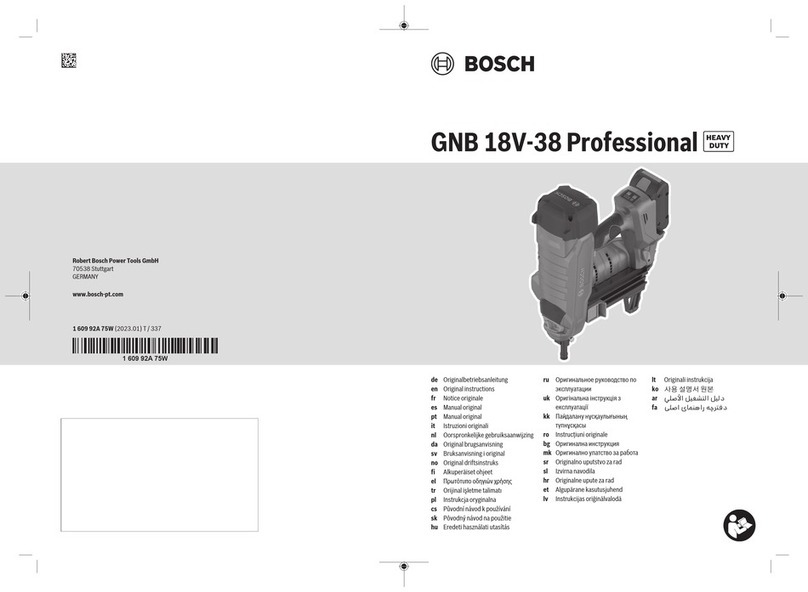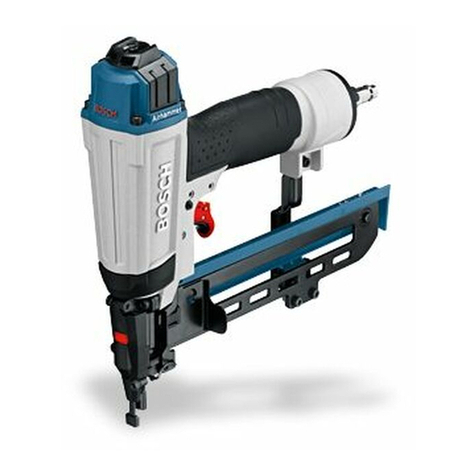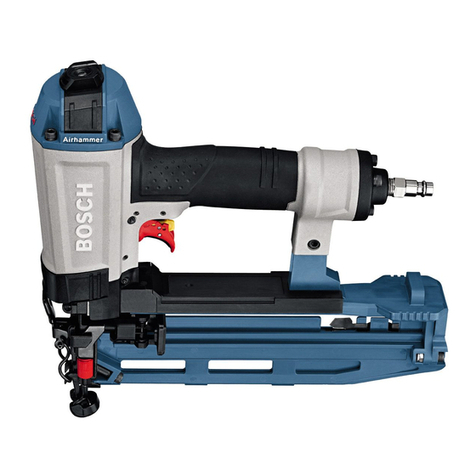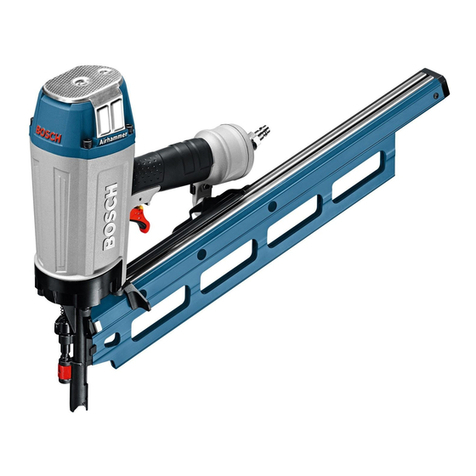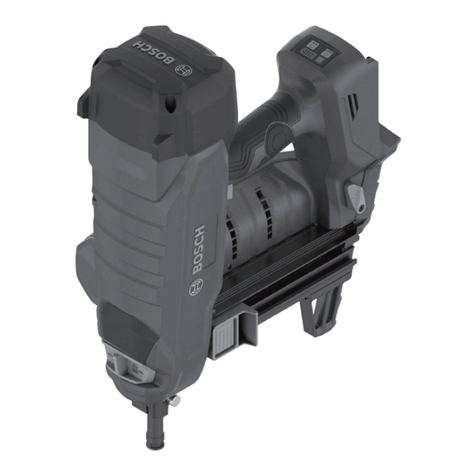
English | 15
Bosch Power Tools 1 609 929 X30 | (22.3.11)
English
Safety Notes
General Safety Rules for Pneumatic Tools
Read and observe all safety warnings and instruc-
tions. Failure to follow the following safety warnings
and instructions may result in electric shock, fire and/or serious injury.
Save all warnings and instructions for future reference.
Work area safety
fKeep work area clean and well lit. Cluttered or dark areas invite acci-
dents.
fDo not operate the pneumatic tool in explosive atmospheres, such
as in the presence of flammable liquids, gases or dusts. While work-
ing the workpiece, sparks can be created which may ignite the dust or
fumes.
fKeep children and bystanders away from your workplace whileop-
erating the pneumatic tool. Distractions from other persons can
cause you to lose control over the pneumatic tool.
Pneumatic tool safety
fUse compressed air of Quality Class 5 in accordance with DIN ISO
8573-1 and a separate maintenance unit close to the pneumatic
tool. The compressed air supplied should be free of foreign material
and moisture to protect the pneumatic tool from damage, contamina-
tion, and the formation of rust.
fCheck the connections and the air supply lines. All maintenance
units, couplers, and hoses should conform to the product specifica-
tions in terms ofpressure and air volume. Too low pressure impairs the
function of the pneumatic tool; too high pressure can result in material
damage and personal injury.
fProtect the hoses from kinks, restrictions, solvents, and sharp
edges. Keep the hoses away from heat, oil, and rotating parts. Im-
mediately replace a damaged hose. A defective air supply line may
result in a wild compressed-air hose and can cause personal injury.
Raised dust or chips maycause serious eye injury.
fMake sure that hose clamps are always tightened firmly. Loose or
damaged hose clamps may result in uncontrolled air escape.
Personal safety
fStay alert, watch what you are doing, and use common sense when
operatingapneumatictool. Donot usea pneumatictool whiletired
or under the influence of drugs, alcohol, or medication. A moment
of inattention while operating a pneumatic tool may result in personal
injury.
fUse personal protective equipment. Always wear eye protection.
Protective equipment such as dust mask, non-skid safety shoes, hard
hat, or hearing protection used for appropriate conditions will reduce
personal injuries.
fPrevent unintentional starting. Make sure that the pneumatic tool
is switched off before connecting it to the air supply, picking it up
or carrying it. When your finger is on the On/Off switch while carrying
the pneumatic tool or when connecting the pneumatic tool to the air
supply while it is switched on, accidents can occur.
fRemove any adjustment tools before switching on the pneumatic
tool.A wrenchor keyleftattached toa rotating partof apneumatictool
may result in personal injury.
fDo not overreach. Keep proper footing and balance at all times.
This enables better control of the pneumatic tool in unexpected situa-
tions.
fDress properly. Do not wear loose clothing or jewellery. Keep your
hair, clothing and gloves away from moving parts. Loose clothes,
jewellery or long hair can be caught in moving parts.
fIf devices are provided for the connection of dust extraction and
collection facilities, ensure these are connected and properly
used. Use of dust collection can reduce dust-related hazards.
fDo not directly inhale the exhaust air. Avoid exposing the eyesto
exhaust air. The pneumatic tool’s exhaust air can contain water, oil,
metal particles and debris from the compressor. This can cause dam-
age to one‘s health.
Pneumatic tool use and care
fUse the clamping devices or a vice to secure and support the work-
piece. Holding the workpiece by hand or against your body will not al-
low for safe operation of the pneumatic tool.
fDonot overload thepneumatic tool. Use thepneumatic toolintend-
edfor your work.The correct pneumatic tool will do the job better and
safer at the rate for which it is designed.
fDo not use a pneumatic tool that has a defective On/Off switch.A
pneumatic tool that cannot be controlled with the switch is dangerous
and must be repaired.
fDisconnect the air supply before making any adjustments, chang-
ing accessories, or placing the pneumatic tool aside. This safety
measure prevents accidental starting of the pneumatic tool.
fStoreidlepneumatictoolsout ofthereach ofchildren.Do notallow
personsunfamiliarwiththepneumatic toolortheseinstructionsto
operate the device. Pneumatic tools are dangerous in the hands of un-
trained users.
fMaintain the pneumatic tool with care. Check for misalignment or
bindingof movingparts, breakageof partsand anyother condition
that may affect the pneumatic tool’s operation. Have damaged
parts repaired before using the pneumatic tool. Many accidents are
caused by poorly maintained pneumatic tools.
fUsethe pneumatic tool,accessories,application tools, etc.accord-
ing to these instructions. Take into consideration the working con-
ditionsand the activitiesto be carriedout. Use ofthe pneumatictool
for operations different from those intended could result in hazardous
situations.
Service
fHave your pneumatic tool repaired only through a qualified repair
person and only using original replacement parts. This will ensure
that the safety of the pneumatic tool is maintained.
WARNING
OBJ_BUCH-1302-001.book Page 15 Tuesday, March 22, 2011 11:17 AM
